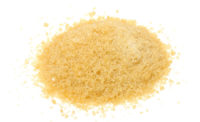Ingredients
Gums, binders and emulsifiers: Cleaning up labels
Processors experiment with clean-label-friendly gums, binders and emulsifiers.




Recently, Oscar Mayer cleaned up its hot dog ingredient labels, replacing all artificial preservatives, added nitrates and added nitrites with celery juice. Tyson Foods has also removed nitrates and nitrites from its Ball Park hot dog line. Will other companies follow suit?
Food additives such as nitrites can improve product appearance, texture, taste and freshness. And celery juice certainly sounds healthy to consumers, compared to, say, sodium nitrites. But the celery juice in hot dogs is treated with bacterial culture to turn its natural nitrates into nitrites, which fulfill the same function as before — provide color, improve shelf life and prevent foodborne illnesses.
“Clean labels are huge; processors are trying to use ingredients with understandable names,” says Rodrigo Tarté, Ph.D., assistant professor at Iowa State University, in Ames, Iowa. “A disdain for ingredients with names that are unrecognizable by the average consumer has directed the spotlight on certain tried and true ingredients like nitrites, nitrates, phosphates, erythorbate and ascorbate. But natural alternatives are more expensive, so not every company will want to go in that direction.”
According to Tarté, certain binder ingredients (as long as they have recognizable names) have been used to simulate some of the functional properties of phosphate, with varying degrees of success. Cherry powder, for example, is being used as a natural alternative for erythorbate and ascorbate, and celery powder, as previously mentioned, can replace nitrites.
“The food and meat industry and ingredient suppliers are fully hands on board with continuing to look at natural alternatives to these ingredients,” says Tarté.
Gumming up labels
Gums play a different role and are used to extend the meat or deli product. One pound of deli turkey, for example, could be lengthened to 1.2 or 1.5 pounds with the use of gums (or extenders).
“They also add flavor, moisture and texture,” says Dennis Seisun, owner of IMR International and a food and beverages consultant based in San Diego. “In comparison tests of meat with gums or extenders compared to those with none, consumers overall prefer the product with extenders.”
Yet, as processors attempt to provide clean or simple labels to consumers by reducing the number of ingredients in their products, gums and binders stand out on product labels.
Even deli or institutional food manufacturers are starting to be concerned about food additives, even though consumers typically do not see an ingredient list, Seisun says.
“Less is cleaner, as far as consumers are concerned,” Seisun says.
What’s in a name? A lot, apparently. “Ingredients like carrageenan have been victims of the clean-label movement — or anything with a chemical-sounding name,” says Tarté. “The fact that carrageenan comes from seaweed seems to only make it appear worse. So ingredient options are becoming fewer.”
The Food Babe has mobilized social media followers to join her campaign against carrageenan, a binder. “It’s a little under the gun in the United States from a consumer standpoint, suffering more in dairy than in meat products though,” Seisun says. “Also, its availability has tightened and prices are going up because of the weather in the Philippines and Indonesia where much of the world’s carrageenan is produced.”
Xanthan gum is also struggling with public perception. “People are irrationally concerned with ingredients starting with the letter X; however, xanthan gum is one of the most widely used binders and is also gluten-free,” Seisun says.
The emulsifier gum arabic is being re-branded as acacia gum to sound more appealing on a label, as well, Seisun says.
Modified corn starches have also fallen out of favor as a binder for native starches. “Starches that are from nature are good for some uses and not others,” Tarté says. “Lots of R&D work is taking place with native starches in order to improve on their limited functional properties.”
Avoiding cross-contamination
Binders can be plant-based or dairy-based, says Tarté, so allergenicity is always a concern.
“Many companies stay away from plant-based proteins for that reason,” Tarté says. “The allergen issue is significant, in many cases not so much from the consumer point of view — we hope they read product labels — but from issues of cross-contamination at the manufacturing-plant level.”
If a product uses soy, for example, and it goes airborne, it could potentially contaminate batches that don’t use soy.
Fibers from sources such as oat, carrot, pea and citrus, as well as rice bran, show promise because they are non-allergenic and clean-label-friendly.
“We see a lot of potential in these ingredients, because they are carbohydrates [not protein-based] and functional,” Tarté says.
Working with retailers
Retailers are taking on a pseudo regulatory role as they are asking for more disclosure and transparency than, in many cases, even the United States Department of Agriculture (USDA) or Food and Drug Administration (FDA), Tarté says.
“If a company sells products at Whole Foods, for example, they have to meet their specific standards, many of which are stricter than those of USDA and FDA regulations,” Tarté says. “This is a big change in retail, and it’s spilling over into foodservice.”
In addition, other retailers also have their own set of standards, which, while similar to each other, still contain some differences that food manufacturers must keep in mind, Tarté says.
Ultimately, processors will have to weigh the pros and cons of using available gums, binders and emulsifiers against the public’s perception of their benefits. NP
Looking for a reprint of this article?
From high-res PDFs to custom plaques, order your copy today!











